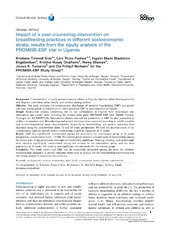| dc.contributor.author | Eide, Kristiane Tislevoll | en_US |
| dc.contributor.author | Fadnes, Lars Thore | en_US |
| dc.contributor.author | Engebretsen, Ingunn Marie S. | en_US |
| dc.contributor.author | Onarheim, Kristine Husøy | en_US |
| dc.contributor.author | Wamani, Henry | en_US |
| dc.contributor.author | Tumwine, James K | en_US |
| dc.contributor.author | Norheim, Ole Frithjof | en_US |
| dc.date.accessioned | 2017-06-09T11:35:58Z | |
| dc.date.available | 2017-06-09T11:35:58Z | |
| dc.date.issued | 2016-07-28 | |
| dc.Published | Eide KT, Fadnes LT, Engebretsen IMS, Onarheim KH, Wamani H, Tumwine JK, Norheim OF. Impact of a peer-counseling intervention on breastfeeding practices in different socioeconomic strata: results from the equity analysis of the PROMISE-EBF trial in Uganda. Global health action. 2016;9:30578 | eng |
| dc.identifier.issn | 1654-9880 | |
| dc.identifier.uri | https://hdl.handle.net/1956/15952 | |
| dc.description.abstract | Background: Undernutrition is highly prevalent among infants in Uganda. Optimal infant feeding practices may improve nutritional status, health, and survival among children. Objective: Our study evaluates the socioeconomic distribution of exclusive breastfeeding (EBF) and growth outcomes among infants included in a trial, which promoted EBF by peer counselors in Uganda. Design: Twenty-four clusters comprising one to two communities in Uganda were randomized into intervention and control arms, including 765 mother-infant pairs (PROMISE-EBF trial, 200608, ClinicalTrials.gov no. NCT00397150). Intervention clusters received the promotion of EBF by peer counselors in addition to standard care. Breastfeeding and growth outcomes were compared according to wealth quintiles and intervention/control arms. Socioeconomic inequality in breastfeeding and growth outcomes were measured using the concentration index 12 and 24 weeks postpartum. We used the decomposition of the concentration index to identify factors contributing to growth inequality at 24 weeks. Results: EBF was significantly concentrated among the poorest in the intervention group at 24 weeks postpartum, concentration index 0.060. The control group showed a concentration of breastfeeding among the richest part of the population, although not statistically significant. Stunting, wasting, and underweight were similarly significantly concentrated among the poorest in the intervention group and the total population at 24 weeks, but showing non-significant concentrations for the control group. Conclusion: This study shows that EBF can be successfully promoted among the poor. In addition, socioeconomic inequality in growth outcomes starts early in infancy, but the breastfeeding intervention was not strong enough to counteract this influence. | en_US |
| dc.language.iso | eng | eng |
| dc.publisher | Co-Action Publishing | eng |
| dc.rights | Attribution CC BY | eng |
| dc.rights.uri | http://creativecommons.org/licenses/by/4.0 | eng |
| dc.subject | anthropometry | eng |
| dc.subject | exclusive breastfeeding | eng |
| dc.subject | infant health | eng |
| dc.subject | Socio-economic factors | eng |
| dc.subject | Uganda | eng |
| dc.subject | undernutrition | eng |
| dc.title | Impact of a peer-counseling intervention on breastfeeding practices in different socioeconomic strata: results from the equity analysis of the PROMISE-EBF trial in Uganda | en_US |
| dc.type | Peer reviewed | |
| dc.type | Journal article | |
| dc.date.updated | 2017-05-09T08:39:42Z | |
| dc.description.version | publishedVersion | en_US |
| dc.rights.holder | Copyright 2016 The Author(s) | |
| dc.identifier.doi | https://doi.org/10.3402/gha.v9.30578 | |
| dc.identifier.cristin | 1439717 | |
| dc.source.journal | Global health action | |

